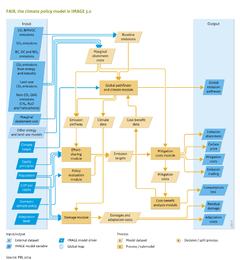Climate policy/Description: Difference between revisions
Jump to navigation
Jump to search
No edit summary |
Oostenrijr (talk | contribs) m (Text replace - "CO2 " to "CO<sub>2</sub>") |
||
| Line 13: | Line 13: | ||
===Mitigation costs module=== | ===Mitigation costs module=== | ||
The Mitigation costs module is used for calculating the regional mitigation costs of achieving the targets calculated in the Policy Evaluation and/or the Effort Sharing modules, and to determine the buyers and sellers on the international emissions trading market ([[Den Elzen et al., 2008]]; [[Den Elzen et al., 2011a]]). Inputs to the model are regional gas- and source-specific Marginal Abatement Cost (MAC) curves that reflect the additional costs of abating one extra tonne of | The Mitigation costs module is used for calculating the regional mitigation costs of achieving the targets calculated in the Policy Evaluation and/or the Effort Sharing modules, and to determine the buyers and sellers on the international emissions trading market ([[Den Elzen et al., 2008]]; [[Den Elzen et al., 2011a]]). Inputs to the model are regional gas- and source-specific Marginal Abatement Cost (MAC) curves that reflect the additional costs of abating one extra tonne of CO<sub>2</sub>equivalent emissions. The {{abbrTemplate|MAC}} curves describe the potential and costs of the abatement options considered. The model uses aggregated regional permit demand and supply curves derived from the MAC curves to calculate the equilibrium permit price on the international trading market, its buyers and sellers, and the resulting domestic and external abatement per region. The design of the emissions trading market can include: constraints on imports and exports of emission permits; non-competitive behaviour; transaction costs associated with the use of emission trading; a less than fully efficient supply of viable {{abbrTemplate|CDM}} projects with respect to their operational availability; and the banking of surplus emission allowances. | ||
===Damage and Cost-Benefit Analysis modules=== | ===Damage and Cost-Benefit Analysis modules=== | ||
Revision as of 10:24, 1 July 2014
Parts of Climate policy/Description
| Component is implemented in: |
|
| Related IMAGE components |
| Models/Databases |
| Key publications |
| References |
|
